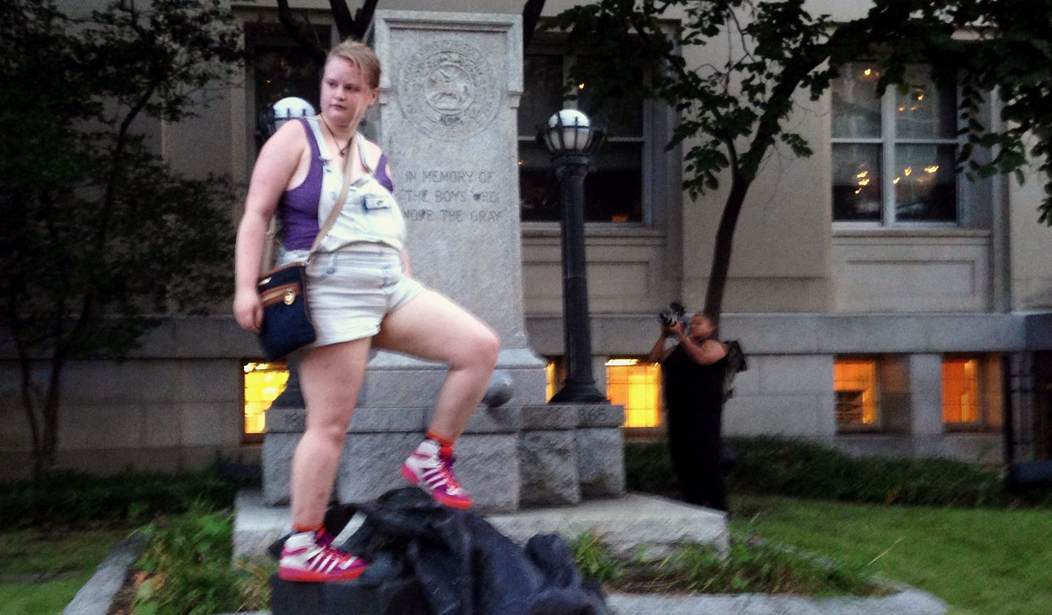The University of Pennsylvania campus in West Philadelphia is a long and spiraling network of old buildings, crosswalks, and pedestrian bridges linking the Penn Library (where one may examine the papers of essayist Agnes Repplier) and the Kelly Writers House (where Susan Sontag once described the public reaction to her New Yorker essay on the September 11th attack in New York City). In the 1970s, the Penn campus was a major hangout of Ira Einhorn, founder of Earth Day and touted as a Philadelphia notable by city politicians until he was arrested for murdering and stuffing the body of his girlfriend, Holly Maddux, inside a trunk in his Powelton Village apartment.
Outwardly, the Penn campus is a pretty quiet place, although in 2017 the student newspaper, The Daily Pennsylvanian, reported that neo-Nazi posters were appearing on campus with messages like “Stop the blacks,” and “Join your local Nazis.” While Penn has a policy that “no poster shall be prohibited or restricted solely on basis of content,” enough students were riled up to attract the attention of local media. Although the offending posters mysteriously disappeared shortly after their discovery, student activists covered the “LOVE” sculpture near City Hall with hundreds of anti-Nazi posters warning “We are ready to resist.”
But resist what? Neo-Nazi sympathizers in the city of Philadelphia are about as numerous as sub-groups of transgender Mennonites. If there are any neo-Nazis here, they are quiet basement dwellers who rarely make public appearances. The zero-to-none neo-Nazi activity in Philadelphia suggests that the “Nazi” posters were put up by leftists so that they would have something to protest against. False flag operations are common on the Left, since it is the Left that pushes for fascist, totalitarian interdiction of freedom of speech.
The Left, of course, also likes to espouse its calumny anonymously, because it is not interested in freedom or justice but rather seeks to control lives by government-enforced restrictions on freedom.
To understand all things Penn, one must look into the phenomenon of the “Penn Face.” In April of this year, CBS Philly produced a report on suicide on the Penn campus focused mainly on the death of Penn undergrad Olivia Kong, who climbed onto the tracks at 40th Street in front of an oncoming train. Prior to Kong’s death, 14 Penn students lost their lives at their own hands since 2013. The attorney for Kong’s family — Kong’s family believes that the university could have done something to save their troubled daughter’s life — said that Kong’s problems and personal issues were all hidden behind the “Penn Face.”
“There seems to be something unique about Penn that it is not only a pressure cooker, but there’s this culture where the students are almost not permitted to show any vulnerability,” Nelson Shepherd, the Kong family attorney, told the press.
Hiding that student vulnerability has come to be known as “Penn Face,” even if that “Penn Face” can be found all over the Penn campus in many incarnations. The biggest “Penn Face” story perhaps started in 2006 when the Daily Pennsylvanian reported that Penn had no ties to slavery:
In recent weeks, Yale and Harvard universities’ colonial connections to the slave trade have also received attention. Stained glass windows at Yale, for example, depict slaves working in cotton fields.
Penn’s history, however, was unmarred by slavery, unlike some of its Ivy League peers, according to University Archivist Mark Lloyd.
‘Our 18th century trustees are not known to have profited from the slave trade,’ Lloyd said, adding that Pennsylvania history puts Penn in a different situation from some of its peers.
‘I’m confident that Pennsylvania was very different from nearby colonies because of the Quaker tradition,’ Lloyd said.”
Penn reiterated its affiliation to slavery as late as 2016 when the Philadelphia Tribune reported: “Penn has explored this issue several times over the past few decades and found no direct university involvement with slavery or the slave trade.”
An independent study backed by Penn’s History Department, published this year, documented the discovery that 20 of the university’s founding trustees had major connections to slavery. The Daily Pennsylvanian then reported that the school did have serious ties to the slave trade. (This, by the way, added yet another “Penn Face.”)
The Penn Slavery Project has received a fair amount of notoriety and publicity. One of the Project leaders, VanJessica Gladney, wrote:
The early trustees of the University of Pennsylvania helped design symbols of American freedom while keeping other men in bondage. According to notes from the Continental Congress, Francis Hopkinson, an early trustee and slave owner, designed America’s very first flag. Isaac Norris Jr., another trustee and slave owner, chose the inscription for the bell, now known as the ‘Liberty Bell,’ that hung in the Pennsylvania State House. … Seven of the early trustees of the University of Pennsylvania signed the Declaration of Independence, eight signed the United States Constitution, and four signed both: George Clymer, Robert Morris, James Wilson, and Benjamin Franklin. Though Clymer’s record has not been searched, we know that the last three men owned slaves. They signed a document declaring all men equal, and owned men they deemed unworthy of those same rights.
One can easily askwhat will happen now at Penn to remake yet another “Penn Face,” a face that might easily reflect what happened at Yale University in 2016 when school administrators there refused to capitulate to student protests and rename its John C. Calhoun College. Calhoun (1782-1850) called slavery “a positive good.” Yale administrators were at first adamant that they would not rename the College. “We cannot erase American history but we can confront it, teach it, and learn from it,” the president of the university said. But one year later the university was singing a different tune as a result of increased student protests. It decided to rename the College in honor of Grace Murray Hopper, a 1930 graduate of the school and a rear admiral in the U.S. Navy. A fine woman indeed, but what happened to the feared erasure of American history?
“In making this change,” the president of Yale noted, “we must be vigilant not to erase the past. To that end, we will not remove symbols of Calhoun from elsewhere on our campus, and we will develop a plan to memorialize the fact that Calhoun was a residential college name for 86 years. Furthermore, alumni of the college may continue to associate themselves with the name Calhoun College.”
One can almost see the future in the president’s words: the gradual elimination of the name Calhoun in any context whatsoever. This is sure to happen because over time new crops of students will want complete erasure of Calhoun’s legacy. Renaming the College will not be enough. This sort of incremental historical slaughter will end in the eventual banishment of anything named Calhoun at Yale, and it will also have a similar effect at Penn.
“Our university was indeed complicit in slavery,” Penn’s Carson Eckhard (C ’21) noted. “If we want to be the institution we claim to be, we must acknowledge all aspects of Penn’s complicated legacy and proceed accordingly.”
“Proceed accordingly,” of course, suggests highly negative consequences for those Penn trustees tarnished with the brush of slavery. After all, the Project so far has only investigated 28 trustees out of 128. A lot more sins of the fathers are about to be revealed.
Walk the Penn campus and you’ll find regal statues of men like George Whitefield, an 18th century evangelical minister, or William Pepper, from the class of 1862 and a graduate of Penn Medical School in 1864 and the 11th provost of the University. There’s wealthy Charles Lenning, a chemist, who gave $700,000 to the school in 1891, and Edgar Fahs Smith, Penn’s 13th provost (1911-1920), all possible sinners who may one day have to pay like Yale’s John C. Calhoun.
It is almost certain that some or all of these men will face incremental historical erasure — the ultimate “Penn Face”– as the History of Slavery Project grows in ideological intensity.









Join the conversation as a VIP Member